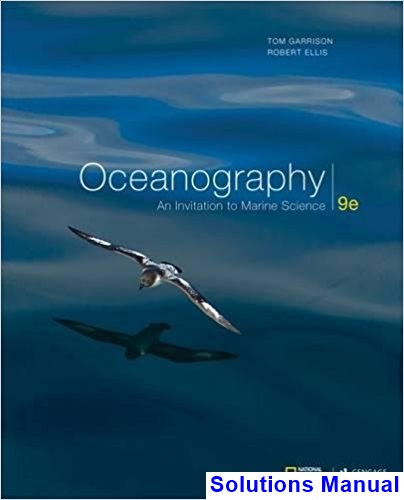Oceanography An Invitation to Marine Science 9th Edition Garrison Solutions Manual

Product details:
- ISBN-10 : 1305105168
- ISBN-13 : 978-1305105164
- Author: Tom Garrison
Developed in partnership with the National Geographic Society, market-leading OCEANOGRAPHY: AN INVITATION TO MARINE SCIENCE, 9e gives you a basic understanding of the scientific questions, complexities, and uncertainties involved in ocean use-as well as the role and importance of the ocean in nurturing and sustaining life on Earth. Seasoned researchers Tom Garrison and Robert Ellis emphasize the interdisciplinary nature of marine science, stressing its links to biology, chemistry, geology, physics, meteorology, astronomy, ecology, history, and economics. The book’s focus on the science process includes numerous “How Do We Know?” boxes detailing the science behind how oceanographers know what they know. Coverage of climate change has been updated to reflect the latest findings. In addition, Chapter 14 “Primary Producers” includes expanded coverage of photosynthetic and chemosynthetic producers to help you understand the “big picture” in marine biology.
Table contents:
- Ch 1: The Origin of the Ocean
- Ch 1: Key Concepts
- 1.1: Earth Is an Ocean World
- 1.2: Marine Scientists Use the Logic of Science to Study the Ocean
- 1.3: Stars Form Seas
- 1.4: Earth, Ocean, and Atmosphere Accumulated in Layers Sorted by Density
- 1.5: Life Probably Originated in the Ocean
- 1.6: What Will Be Earth’s Future?
- 1.7: Are There Other Ocean Worlds?
- Ch 1: Questions from Students
- Ch 1: Terms and Concepts to Remember
- Ch 1: Study Questions
- Ch 1: Global Geoscience Watch
- Ch 2: A History of Marine Science
- Ch 2: Key Concepts
- 2.1: Understanding the Ocean Began with Voyaging for Trade and Exploration
- 2.2: The Age of European Discovery
- 2.3: Voyaging Combined with Science to Advance Ocean Studies
- 2.4: The First Scientific Expeditions Were Undertaken by Governments
- 2.5: Contemporary Oceanography Makes Use of Modern Technology
- Ch 2: Questions from Students
- Ch 2: Terms and Concepts to Remember
- Ch 2: Study Questions
- Ch 2: Global Geoscience Watch
- Ch 3: Earth Structure and Plate Tectonics
- Ch 3: Key Concepts
- 3.1: Pieces of Earth’s Surface Look Like They Once Fit Together
- 3.2: Earth’s Interior Is Layered
- 3.3: The Study of Earthquakes Provides Evidence for Layering
- 3.4: Earth’s Inner Structure Was Gradually Revealed
- 3.5: The New Understanding of Earth Evolved Slowly
- 3.6: Wegener’s Idea Is Transformed
- 3.7: The Breakthrough: From Seafloor Spreading to Plate Tectonics
- 3.8: Plates Interact at Plate Boundaries
- 3.9: A Summary of Plate Interactions
- 3.10: The Confirmation of Plate Tectonics
- 3.11: Scientists Still Have Much to Learn about the Tectonic Process
- Ch 3: Questions from Students
- Ch 3: Terms and Concepts to Remember
- Ch 3: Study Questions
- Ch 3: Global Geoscience Watch
- Ch 4: Ocean Basins
- Ch 4: Key Concepts
- 4.1: The Ocean Floor Is Mapped by Bathymetry
- 4.2: Ocean-Floor Topography Varies with Location
- 4.3: Continental Margins May Be Active or Passive
- 4.4: The Topography of Deep-Ocean Basins Differs from That of the Continental Margin
- 4.5: The Marine Environment Is Classified in Distinct Zones
- 4.6: The Grand Tour
- Ch 4: Questions from Students
- Ch 4: Terms and Concepts to Remember
- Ch 4: Study Questions
- Ch 4: Global Geoscience Watch
- Ch 5: Sediments
- Ch 5: Key Concepts
- 5.1: Ocean Sediments Vary Greatly in Appearance
- 5.2: Sediments Are Classified by Particle Size
- 5.3: Sediments May Be Classified by Source
- 5.4: Neritic Sediments Overlie Continental Margins
- 5.5: Pelagic Sediments Vary in Composition and Thickness
- 5.6: Researchers Have Mapped the Distribution of Deep-Ocean Sediments
- 5.7: Geologists Use Specialized Tools to Study Ocean Sediments
- 5.8: Sediments Are Historical Records of Ocean Processes
- 5.9: Marine Sediments Are Economically Important
- Ch 5: Questions from Students
- Ch 5: Terms and Concepts to Remember
- Ch 5: Study Questions
- Ch 5: Global Geoscience Watch
- Ch 6: Water and Ocean Structure
- Ch 6: Key Concepts
- 6.1: A Note to the Reader
- 6.2: Familiar, Abundant, and Odd
- 6.3: The Water Molecule Is Held Together by Chemical Bonds
- 6.4: Water Has Unusual Thermal Characteristics
- 6.5: Surface Water Moderates Global Temperature
- 6.6: The Ocean Is Stratified by Density
- 6.7: Refraction Can Bend the Paths of Light and Sound through Water
- 6.8: Light Does Not Travel Far through the Ocean
- 6.9: Sound Travels Much Farther Than Light through the Ocean
- Ch 6: Questions from Students
- Ch 6: Terms and Concepts to Remember
- Ch 6: Study Questions
- Ch 6: Global Geoscience Watch
- Ch 7: Ocean Chemistry
- Ch 7: Key Concepts
- 7.1: Water Is a Powerful Solvent
- 7.2: Seawater Consists of Water and Dissolved Solids
- 7.3: Gases Dissolve in Seawater
- 7.4: The Ocean’s Acid–Base Balance Varies with Dissolved Components and Depth
- Ch 7: Questions from Students
- Ch 7: Terms and Concepts to Remember
- Ch 7: Study Questions
- Ch 7: Global Geoscience Watch
- Ch 8: Circulation of the Atmosphere
- Ch 8: Key Concepts
- 8.1: The Atmosphere and Ocean Interact with Each Other
- 8.2: The Atmosphere Is Composed Mainly of Nitrogen, Oxygen, and Water Vapor
- 8.3: The Atmosphere Moves in Response to Uneven Solar Heating and Earth’s Rotation
- 8.4: Atmospheric Circulation Generates Large-Scale Surface Wind Patterns
- 8.5: Storms Are Variations in Large-Scale Atmospheric Circulation
- 8.6: Katrina and Sandy
- Ch 8: Questions From Students
- Ch 8: Terms and Concepts to Remember
- Ch 8: Study Questions
- Ch 8: Global Geoscience Watch
- Ch 9: Circulation of the Ocean
- Ch 9: Key Concepts
- 9.1: Mass Flow of Ocean Water Is Driven by Wind and Gravity
- 9.2: Surface Currents Are Driven by the Winds
- 9.3: Surface Currents Affect Weather and Climate
- 9.4: Wind Can Cause Vertical Movement of Ocean Water
- 9.5: El Niño and La Niña Are Exceptions to Normal Wind and Current Flow
- 9.5: Thermohaline Circulation Affects All the Ocean’s Water
- Ch 9: Questions from Students
- Ch 9: Terms and Concepts to Remember
- Ch 9: Study Questions
- Ch 9: Global Geoscience Watch
- Ch 10: Waves
- Ch 10: Key Concepts
- 10.1: Ocean Waves Move Energy across the Sea Surface
- 10.2: Waves Are Classified by Their Physical Characteristics
- 10.3: The Behavior of Waves Is Influenced by the Depth of Water through Which They Are Moving
- 10.4: Wind Blowing over the Ocean Generates Waves
- 10.5: Interference Produces Irregular Wave Motions
- 10.6: Deep-Water Waves Change to Shallow-Water Waves as They Approach Shore
- 10.7: Internal Waves Can Form between Ocean Layers of Differing Densities
- 10.8: “Tidal Waves” Are Probably Not What You Think
- 10.9: Storm Surges Form beneath Strong Cyclonic Storms
- 10.10: Water Can Rock in a Confined Basin
- 10.11: Water Displacement Causes Tsunami and Seismic Sea Waves
- Ch 10: Questions from Students
- Ch 10: Terms and Concepts to Remember
- Ch 10: Study Questions
- Ch 10: Global Geoscience Watch
- Ch 11: Tides
- Ch 11: Key Concepts
- 11.1: Tides Are the Longest of All Ocean Waves
- 11.2: Tides Are Forced Waves Formed by Gravity and Inertia
- 11.3: The Dynamic Theory of Tides Adds Fluid Motion Dynamics to the Equilibrium Theory
- 11.4: Most Tides Can Be Accurately Predicted
- 11.5: Tidal Patterns Can Affect Marine Organisms
- 11.6: Power Can Be Extracted from Tidal Motion
- Ch 11: Questions from Students
- Ch 11: Terms and Concepts to Remember
- Ch 11: Study Questions
- Ch 11: Global Geoscience Watch
- Ch 12: Coasts
- Ch 12: Key Concepts
- 12.1: Coasts Are Shaped by Marine and Terrestrial Processes
- 12.2: Erosional Processes Dominate Some Coasts
- 12.3: Beaches Dominate Depositional Coasts
- 12.4: Larger-Scale Features Accumulate on Depositional Coasts
- 12.5: Biological Activity Forms and Modifies Coasts
- 12.6: Freshwater Meets the Ocean in Estuaries
- 12.7: The Characteristics of U.S. Coasts
- 12.8: Humans Interfere in Coastal Processes
- Ch 12: Questions from Students
- Ch 12: Terms and Concepts to Remember
- Ch 12: Study Questions
- Ch 12: Global Geoscience Watch
- Ch 13: Life in the Ocean
- Ch 13: Key Concepts
- 13.1: Life on Earth Is Notable for Unity and Its Diversity
- 13.2: The Concept of Evolution Helps Explain the Nature of Life in the Ocean
- 13.3: Rapid, Violent Change Causes Mass Extinctions
- 13.4: Oceanic Life Is Classified by Evolutionary Heritage
- 13.5: The Flow of Energy Allows Living Things to Maintain Complex Organization
- 13.6: Living Organisms Are Built from a Few Elements
- 13.7: Elements Cycle between Living Organisms and Their Surroundings
- 13.8: Environmental Factors Influence the Success of Marine Organisms
- Ch 13: Questions from Students
- Ch 13: Terms and Concepts to Remember
- Ch 13: Study Questions
- Ch 13: Global Geoscience Watch
- Ch 14: Primary Producers
- Ch 14: Key Concepts
- 14.1: Primary Producers Synthesize Organic Material
- 14.2: Plankton Drift with Ocean Currents
- 14.3: Plankton Collection Methods Depend on the Organism’s Size
- 14.4: Phytoplankton
- 14.5: Lack of Nutrients and Light Can Limit Primary Productivity
- 14.6: Production Equals Consumption at the Compensation Depth
- 14.7: Phytoplankton Productivity Varies with Local Conditions
- 14.8: Seaweeds and Marine Plants Are Diverse and Efficient Primary Producers
- 14.9: Primary Productivity Also Occurs Deep in the Water Column, at Hydrothermal Vents, in Seabed Se
- Ch 14: Questions from Students
- Ch 14: Terms and Concepts to Remember
- Ch 14: Study Questions
- Ch 14: Global Geoscience Watch
- Ch 15: Marine Animals
- Ch 15: Key Concepts
- 15.1: Animals Evolved When Food and Oxygen Became Plentiful
- 15.2: Invertebrates Are the Most Successful and Abundant Animals
- 15.3: The Worm Phyla Are the Link to Advanced Animals
- 15.4: Advanced Invertebrates Have Complex Bodies and Internal Systems
- 15.5: Construction of Complex Chordate Bodies Begins on a Stiffening Scaffold
- 15.6: Vertebrate Evolution Traces a Long and Diverse History
- 15.7: Fishes Are Earth’s Most Abundant and Successful Vertebrates
- 15.8: Fishes Are Successful Because of Unique Adaptations
- 15.9: Sea Turtles and Marine Crocodiles Are Ocean-Going Reptiles
- 15.10: Some Marine Birds Are the World’s Most Efficient Flyers
- 15.11: Marine Mammals Include the Largest Animals Ever to Have Lived
- Ch 15: Questions from Students
- Ch 15: Terms and Concepts to Remember
- Ch 15: Study Questions
- Ch 15: Global Geoscience Watch
- Ch 16: Marine Communities
- Ch 16: Key Concepts
- 16.1: Marine Organisms Live in Communities
- 16.2: Communities Consist of Interacting Producers, Consumers, and Decomposers
- 16.3: Marine Communities Change as Time Passes
- 16.4: Examples of Shoreline Marine Communities
- 16.5: Examples of Shallow Benthic and Open-Ocean Marine Communities
- 16.6: Examples of Deep-Sea Marine Communities
- 16.7: Organisms in Communities Can Live in Symbiosis
- Ch 16: Questions from Students
- Ch 16: Terms and Concepts to Remember
- Ch 16: Study Questions
- Ch 16: Global Geoscience Watch
- Ch 17: Marine Resources
- Ch 17: Key Concepts
- 17.1: Marine Resources Are Subject to the Economic Laws of Supply and Demand
- 17.2: Physical Resources
- 17.3: Renewable Sources of Marine Energy
- 17.4: Biological Resources
- 17.5: Nonextractive Resources Use the Ocean in Place
- 17.6: The Law of the Sea Governs Marine Resource Allocation
- Ch 17: Questions from Students
- Ch 17: Terms and Concepts to Remember
- Ch 17: Study Questions
- Ch 17: Global Geoscience Watch
- Ch 18: The Ocean and the Environment
- Ch 18: Key Concepts
- 18.1: An Introduction to Marine Environmental Issues
- 18.2: Marine Pollutants May Be Natural or Human Generated
- 18.3: Organisms Cannot Prosper if Their Habitats Are Disturbed
- 18.4: Marine Protected Areas Are Refuges
- 18.5: Earth’s Climate Is Changing
- 18.6: What Can Be Done?
- Ch 18: Questions from Students
- Ch 18: Terms and Concepts to Remember
- Ch 18: Study Questions
- Ch 18: Global Geoscience Watch
- Afterword
- Appendix 1: Measurements and Conversions
- Appendix 2: Geologic Time
- Appendix 3: Latitude and Longitude, Time, and Navigation
- Appendix 4: Maps and Charts
- Appendix 5: The Beaufort Scale
- Appendix 6: Taxonomic Classification of Marine Organisms
- Appendix 7: Periodic Table of the Elements
- Appendix 8: Working in Marine Science
- Appendix 9: The World Ocean Seafloor
- Glossary
- Index
- ES-6
- ES-7
People also search:
oceanography an invitation to marine science 9th edition pdf
questions to ask an oceanographer
questions to ask about marine biology
questions to ask a marine biologist
oceanography an invitation to marine science 9th edition
oceanography an invitation to marine science pdf





